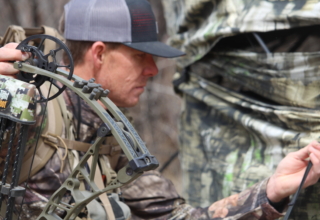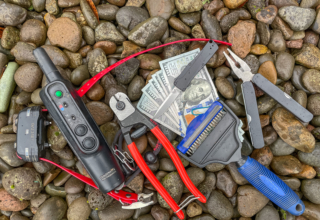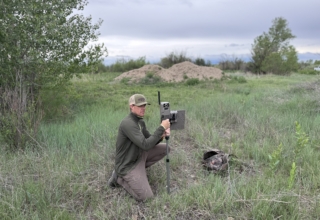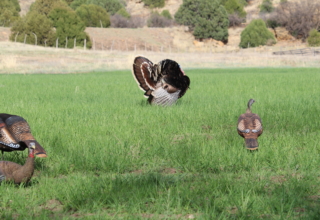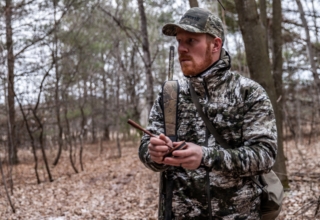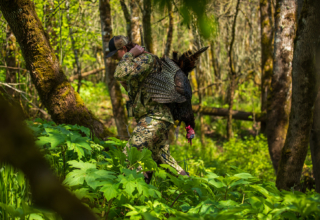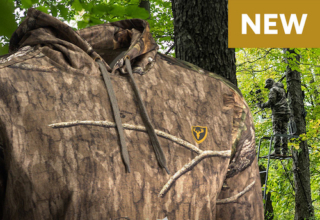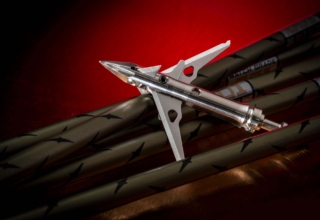The turkey sand is almost through the hourglass, but it’s not too late to tag a late-season tom with your bow.
by Jace Bauserman
If you’ve been on the turkey grind and the stars haven’t lined up, don’t fret; there’s still time to run a sharp carbon stick through a black butterball.
Even better news: You don’t need to be in a ground blind to do it. I love bowhunting turkeys from a ground blind. However, by mid-May, I’m sick of sitting in these hub-style ground forts. Plus, I’m super annoyed with toting them and at least one blind chair around the woods. Now is the time to use a bow-mounted decoy.
When I first started using a bow-mounted turkey decoy, I couldn’t get my mind wrapped around the idea that I wanted turkeys to see me. When using this tactic, you’re the decoy, which is what makes it so intense. It’s just hard to remember that you want to be seen when you’ve spent a lifetime in the woods trying to hide from animals.
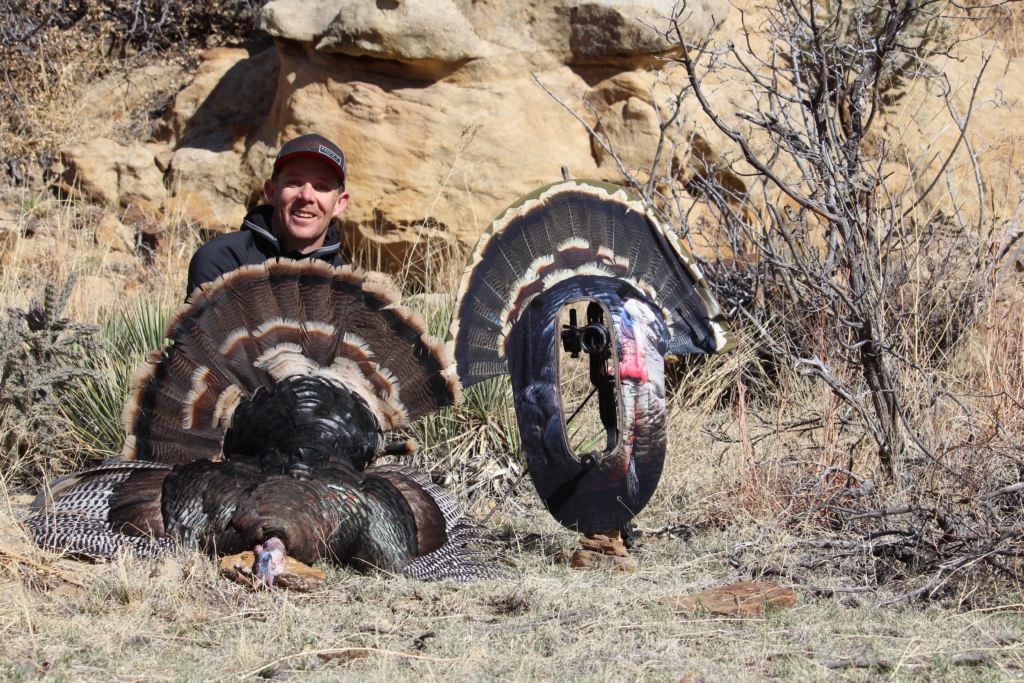
It’s beautiful outside, and the full foliage allows you more cover to lurk around in the woods. Early in the season, when the trees and bushes are bare or budding, it’s too easy for birds to pick you off.
Now, though, you can roam the woods with a bow-mounted decoy and creep in close to those boss gobblers still guarding a hen or two, or those back together boy bands still slinking through the woods hoping to find just one more willing hen.
There’s no better way to bowhunt turkeys than running and gunning with a decoy attached to your bow. Just know that it’s hard. Often, late-season boy birds will tuck their tails and run rather than coming into a fight. However, if you keep going and throw caution to the wind, chances are good you’ll tempt a longbeard into a fight.
When using a bow-mounted decoy, I prefer Ultimate Predator Gear’s MerRio or Eastern, depending on where in the country I’m hunting. These decoys fold up easily to a diameter of less than 11 inches and weigh less than 11 ounces. They are no trouble to tote, and the decoys sport a photographic image of a tom turkey in full strut. Attach the decoy to your bow’s riser or limb pockets via multiple attachment systems, and you’re set to go. The shoot-through window allows maximum arrow clearance. It’s also an excellent peep hole. I love that this decoy doesn’t mount to the side of your bow. You can keep your bow in front of you at all times. Wear a black hat and top to help the decoy’s body blend into your clothing.
I also like the Heads-Up Strutting Turkey Decoy. This decoy sports a circular body style that attaches to a device that mounts to the end of your stabilizer. The Bow Mount is sold separately from the Strutting Turkey Decoy, and you must supply your fan. I love the realism that the fan provides. I have had great success with both systems.

You must practice with these bow-mounted decoys before taking them afield. Both give the bow a different feel, and the first time I used my Heads-Up decoy, I missed three different birds — two toms and a jake — during my maiden in-the-field voyage with it. You need to feel what your bow feels like with your decoy of choice mounted. Both decoys make your bow feel like a kite in the wind, so keep that in mind. Slight wind, if you put in the practice and learn what if feels like is fine, but don’t use these decoys in heavy winds.
What I’ve discovered about running and gunning with a bow-mounted decoy is twofold. First, there is no more thrilling way to bowhunt wild birds. Second, when it works it works and when it doesn’t, it doesn’t. You need to be OK with spooking birds. Again, it’s late in the season, so does it matter? Plus, the birds aren’t spooked by you. They are spooking from a dominant tom (you) they don’t want to deal with.
I do many turkey seminars and have been asked: Have too many birds had their butts whooped late in the season to have success. My answer: No. Again, you’ll have birds run away, and some that act tough at first and then hang up. However, if you keep going, you’ll find an older tom trying to hang around some girls who won’t tolerate it.

I’ve had great success glassing up one or more toms guarding hens and then moving in on them. Typically, you have a much better chance if you can get within 100 yards before showing the bird(s) the decoy.
Another high-success situation is slipping in on a lone tom covering lots of ground and gobbling as he goes. A wandering, gobbling tom is looking for love. I’ve had these birds come running at full tilt during the late season. Years ago, I shot one such bird at 3 yards.

Another made-in-Heaven bow-mounted opportunity is when you can glass a bird’s spurs from a distance. Dominate three-, four-, and those elusive five-year-old birds often won’t tolerate an intruder. A bow-mounted hunt can yield excellent results if you aim to kill an older bird.
I realize many of you have zero interest in jakes. I’m all about each hunter doing whatever makes him/her happy. Jakes make me very happy, and if a stubby beard gives you an ear-to-ear grin, don’t be afraid to show a gaggle of jakes your bow-mounted tom. It’s not uncommon, and during my time in the turkey woods, I’ve seen it often, for a group of jakes to gang up on a lone tom. More than once, I’ve brought multiple jake’s bowhunting close with my bow-mounted tom decoys. I’ve also had a few curious lone jakes come in, though both hung up at 30 yards, forcing me to take a longer shot.
My favorite run-and-gun technique during the late season is the buddy system. Both decoys work well for this. What I love about this style of bowhunting birds is the camaraderie and the fact that I don’t have to have anything extra mounted to my bow. Plus, the decoyer can be more mobile, and the shooter can hang back in the cover if need be.
Note To Jot Down #1: When using a bow-mounted decoy, don’t be afraid to move on birds even when they’re looking at you. If a bird hangs up, I always twist and turn my bow, pushing the fan one way and then another. Sometimes this movement is all it takes to get a bird to resume his approach. If this doesn’t work, I start crawling towards the bird. Twice, I’ve been able to crawl bowhunting close and get shots at uninterested toms.
Note To Jot Down #2: Try not to show the bird or birds the entire decoy. Think about the times you’ve glassed for turkeys. Suddenly, you catch just a piece of a whole fan. Your grip tightens on the binoculars, and you peer hard into them. You scan and scan, but all you see are bits and pieces of the bird. This is the best way to dupe a late-season turkey. Use available cover and even the terrain to disguise the decoy. If you can show a tom the top of the fan, confirm he sees it, and then disappear into the cover, it can be game over. Even a less aggressive tom may wander close, and it’s too late by the time he catches sight of the decoy in the timber you’re hiding in.
Note To Jot Down #3: Check your ego at the door. You won’t have the luxury of being able to tilt your bow downward or upward to reach full draw. You want to be able to hold the bow out in front of you and retract the string in one easy, fluid motion. Don’t be afraid to drop your bow poundage.
Note To Jot Down #4: Be sure to pin every location you have an encounter with a gobbler on your HuntStand App. Then add notes to every encounter. I’ve discovered over the years that certain areas in certain states seem to provided repeated success when going the bow-mounted route.
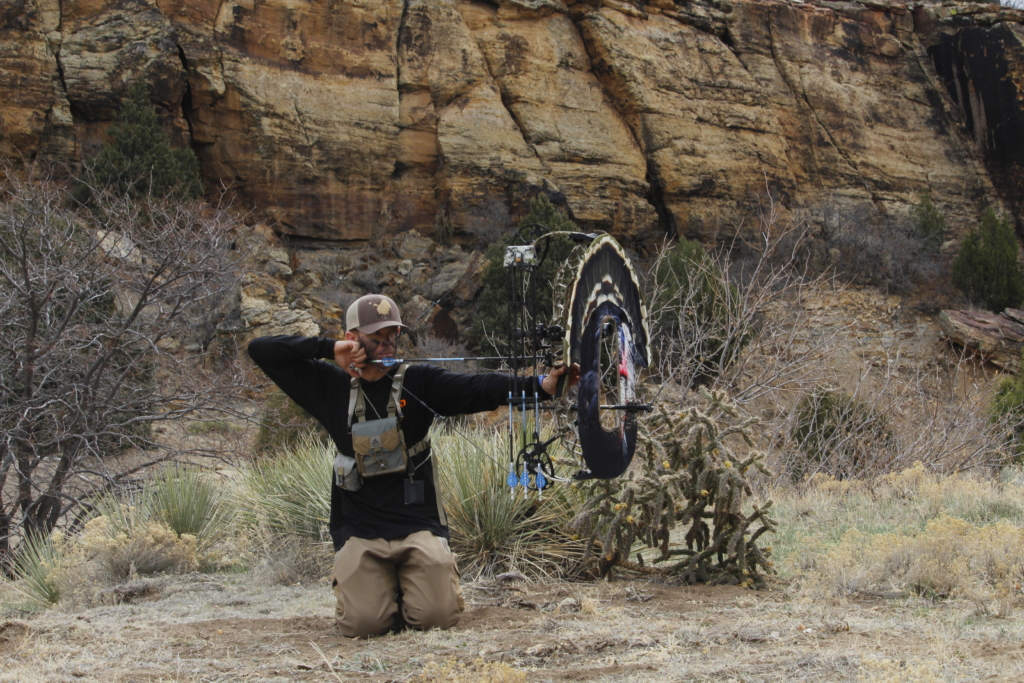
Note To Jot Down #5: You can’t overlook safety when using a bow-mounted decoy. Remember, you are the decoy, and cloth is the only thing separating you from a load of lead or a broadhead-tipped projectile. There are a lot of over-eager hunters out there, and these decoys look very realistic. I rarely use a bow-mounted decoy when hunting public land.
If shotgun season is open, “rarely” becomes never. It’s just not worth it. If I’m hunting public land during the archery-only season or in an archery-only area, I will use a bow-mounted decoy from time to time. I always feel better about the situation if my truck is the only one in the parking lot, or if I have a chance to visit with other hunters sharing the dirt with me. If I get this chance to exchange pleasantries, I always take it. It’s better to work together than to compete against one another if you’re both hunting the area.
I use my bow-mounted decoys a lot more on private land. Most of the time, I have exclusive rights to the land, and when I don’t, I’m typically in contact with the other hunters who share the property with me.
That’s it! Remember, the tips, tactics, and gear mentioned in this piece came from the school of hard knocks. Put them to practice, and I truly believe you will experience your most enjoyable and successful spring to date.


